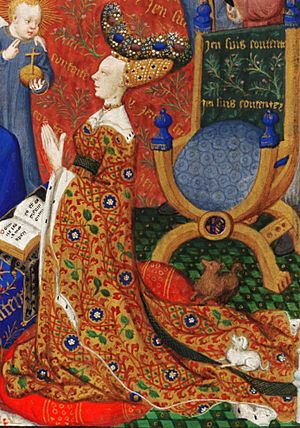Anne of Burgundy facts for kids
Quick facts for kids Anne of Burgundy |
|
|---|---|
| Duchess of Bedford | |
 |
|
| Born | 30 September 1404 |
| Died | 13 November 1432 (aged 28) Hôtel de Bourgogne, Paris |
| Burial | Church of the Celestines, Paris Chartreuse de Champnol, Dijon |
| Spouse | |
| Father | John the Fearless |
| Mother | Margaret of Bavaria |
| Religion | Roman Catholicism |
Anne of Burgundy, Duchess of Bedford (French: Anne de Bourgogne) was born on September 30, 1404. She was a princess from the powerful House of Burgundy. Her father was John the Fearless, who was the Duke of Burgundy. Her mother was Margaret of Bavaria. Anne became an important figure in the history between England and France. She died on November 13, 1432, when she was 28 years old.
Anne Becomes Duchess of Bedford
In June 1423, Anne married John of Lancaster, 1st Duke of Bedford. This wedding took place in a city called Troyes. John was the son of Henry IV of England. Their marriage was a very important part of a peace agreement called the Treaty of Amiens.
This marriage was meant to make the friendship between England and Anne's brother, Philip the Good, Duke of Burgundy, even stronger. This friendship was super important for England to keep winning battles in France. John had been made the Regent of France in 1422. This meant he ruled France because his nephew, Henry VI of England, was only seven months old when his father, Henry V of England, died.
The Duke of Burgundy did not like the House of Valois, who were the French royal family. This dislike caused a big fight in France called the Armagnac–Burgundian Civil War. This fight helped the English win many battles against the French. John and Anne had a happy marriage, but they did not have any children.
Anne and Joan of Arc
Anne was present during the famous trial of Joan of Arc. She, or the women in her household, checked if Joan of Arc was a virgin. They confirmed that she was. Anne was reportedly very impressed by Joan of Arc. She even gave orders that no man, not even guards or high-ranking officials, should touch Joan while she was in prison. Anne also attended Joan of Arc's execution in Rouen in 1431.
Death and Her Legacy
Anne died on November 13, 1432, in Paris. She was buried at a church called the couvent des Célestins. Her heart was buried in a different place, at the couvent des Grands-Augustins. Her tomb was very special and was designed by an artist named Guillaume Vluten. Historians say it was one of the most important tombs in Paris from that time.
Sadly, Anne's original tomb was destroyed in 1849. But two parts of it survived! One part is her gisant, which is a statue of her lying down. You can see it today at the Louvre museum in Paris. The other part is her pleurants, which are statues of people mourning. These are at the Musée de Cluny, a museum about the Middle Ages in Paris.
In 1847, during some digging at the couvent des Célestins, bones were found. A plaque with Anne's name helped people figure out they were her remains. In 1853, her remains were re-buried in the grave of her grandfather, Philip the Bold, in Saint Bégnine cathedral in Dijon.
Anne's death was a turning point for the English. The next year, her husband John married again to Jacquetta of Luxembourg. For different political reasons, this made Anne's brother, Duke Philip, upset. The good relationship between John and Philip became distant. This led to peace talks in 1435 between Burgundy and Charles VII, who was the exiled king of France. Later that year, Philip officially ended his alliance with England.
See also
 In Spanish: Ana de Borgoña para niños
In Spanish: Ana de Borgoña para niños

